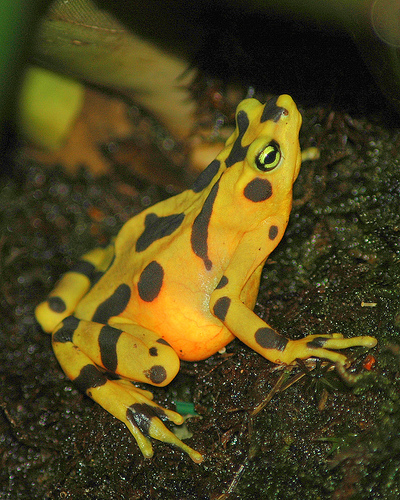
Griffith and Ms. Ross have seen the effects of chytrid firsthand. They were here four years ago when chytrid swept through this part of Panama. Amid the die-off, Griffith, a Panamanian who sports a toad tattoo on his calf, and Ross, a former Peace Corps volunteer from Wisconsin, collected as many frogs as they could house, treating them in baths of fungicide and stashing them in rooms at a nearby hotel until construction on the center was complete. The center is a nondescript building in the back corner of a private zoo. Inside are 200 tanks humming with filters and aglow with ultraviolet lights. The most famous resident is the Panamanian golden frog, brilliant in its taxicab-yellow-and-black colors, but there is also the casque-headed tree frog, with its fearsome horned helmet and appetite for other frogs, and the horned marsupial frog, which stuffs its eggs into a pouch on its back where they grow into froglets. There is the streamside rainfrog, which once lived in the spray zone of waterfalls. There are 15 streamside rainfrogs here and another seven at the Atlanta Botanical Garden. They are the only known survivors of the species and no one has figured out yet how to make them breed.
RPCV Heidi Ross and her husband Edgardo Griffith, opened the El Valle Amphibian Conservation Center in western Panama in 2006 with help from the Houston Zoo
‘Ark’ races to rescue jungle frogs
As lethal fungus spreads, captive amphibians are bred for eventual return to the wild.
By Josephine Hearn | Contributor of The Christian Science Monitor/ February 27, 2009 edition
Caption: Panamanian Golden Frog by ucumari Flickr Creative Commons Attribution-Noncommercial-No Derivative Works 2.0 Generic
Rio Jordanal, Panama
Biologist Edgardo Griffith is ready to find frogs. He has his rubber boots, his plastic bags, his camera, and an intimidating metal hook to turn over rocks and prod logs. But after an hour searching this scenic stream in the cloud forest, he has yet to find a single one.
“Five years ago, if we had come to this stream we would have seen the whole bottom moving just [from] the amount of tadpoles. Now we can’t see any,” he sighs, ankle deep in the currents.
Conservationists predict that in 10 years, every highland stream in Panama will resemble this one, all but devoid of frogs. For now, they see little that can be done about it.
Scientists say that a deadly fungus is moving through mountain streams here and elsewhere, killing as many as 8 out of 10 frogs and extinguishing some species entirely. The enemy is a fungus known as chytrid (KIH-trid) or by its scientific name, Batrachochytrium dendrobatidis. Mr. Griffith and others are trying to stay ahead of the plague by plucking animals from the wild and placing them in captive breeding centers. This effort and similar ones around the world have been dubbed the Amphibian Ark.
In Panama, space for the captured frogs is filling up. Griffith and his wife, Heidi Ross, opened the El Valle Amphibian Conservation Center in western Panama in 2006 with help from the Houston Zoo. They house more than 600 frogs and expect to complete another wing in March. Plans are under way for a second amphibian
conservation center at the Summit Municipal Park in Panama City, which will shelter species from eastern Panama as chytrid cuts a lethal path through that region.
The facility here is unusual in Central America. In many other places, expansion plans are few and tank space for amphibians is limited.
“There are more species in need of rescue than there are resources to rescue them,” says Kevin Zippel, Amphibian Ark’s program director, who is based in upstate New York. “By an order of magnitude, that’s true.”
The scattered Ark in some ways resembles the well-known California Condor Recovery Program, in which biologists captured the remaining nine wild birds in the 1980s, bred them, and eventually returned them to the wild, where their numbers have risen to more than 300 with supplementation from captive stocks.
The Ark encompasses more than just a single breeding program, and the obstacles it faces are more grave. Dr. Zippel estimates that 500 species need such “escape pods” from chytrid and other environmental threats, yet only 40 to 50 species are involved in such programs. Unlike the condor, amphibians are often mysteries to science, their habits and needs poorly studied. That makes captive programs experiments in trial and error. And before reintroduction efforts can even begin, scientists must find some way to overcome the presence of chytrid in native habitats. These might include vaccines, breeding for resistance, or genetic engineering of the fungus.
Still, many scientists see no other option.
“When you’re talking about insidious threats like disease or climate change,” Zippel says, “threats that can’t be mitigated in the wild, there’s simply no alternative.”
Fungus linked to climate change, or Africa
Chytrid appeared in Costa Rica in the 1980s. It crossed the border into Panama in the ’90s and has been marching across the isthmus at a rate of about 13 miles per year, according to one estimate. Some scientists link chytrid outbreaks to the varying effects of climate change, while others see it as a foreign pathogen that originated perhaps in Africa and is now invading new territory.
What is certain is its virulence. Once the first dead frog appears, dozens of others follow in a few weeks, then hundreds, and then thousands until several months later, many species are gone. The fungus needs cool temperatures, which is why it has been so devastating to higher-altitude streams.
Griffith and Ms. Ross have seen the effects of chytrid firsthand. They were here four years ago when chytrid swept through this part of Panama. Amid the die-off, Griffith, a Panamanian who sports a toad tattoo on his calf, and Ross, a former Peace Corps volunteer from Wisconsin, collected as many frogs as they could house, treating them in baths of fungicide and stashing them in rooms at a nearby hotel until construction on the center was complete.
The center is a nondescript building in the back corner of a private zoo. Inside are 200 tanks humming with filters and aglow with ultraviolet lights. The most famous resident is the Panamanian golden frog, brilliant in its taxicab-yellow-and-black colors, but there is also the casque-headed tree frog, with its fearsome horned helmet and appetite for other frogs, and the horned marsupial frog, which stuffs its eggs into a pouch on its back where they grow into froglets. There is the streamside rainfrog, which once lived in the spray zone of waterfalls. There are 15 streamside rainfrogs here and another seven at the Atlanta Botanical Garden. They are the only known survivors of the species and no one has figured out yet how to make them breed.
Conservationists believe that housing amphibians in-country is a better option than shipping them to the United States, where they might spread disease or fall prey to local pathogens. According to one theory, chytrid itself spread around the world when the African clawed toad, an asymptomatic carrier of the fungus, facilitated human pregnancy tests. (The toad shares hormones with human females, so a quick injection with a pregnant woman’s urine and the female toad ovulated – a positive result.)
Where do you get 100,000 crickets?
Keeping frogs in Panama presents its own challenges.
“In the States you can get on the phone and order 100,000 crickets, and they’ll be there in two days,” says Paul Crump, amphibian conservation manager at the Houston Zoo, the driving force behind the center. “You just can’t do that here.” So Griffith and Ross breed crickets on site in egg cartons.
Conservationists here are budgeting for 25 years of captive breeding, long enough, they believe, for scientists to find some response to chytrid. Griffith is confident that a solution will emerge. What worries him more is advancing development in Panama, driven in part by US citizens seeking retirement homes in the cloud forest. When the day comes for the frogs to go home, they may have no place to go.
“The chytrid we can fight,” he says. “It’s a microorganism. But people we can’t fight.”












